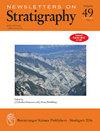Redox element record shows that environmental perturbations associated with the T-OAE were of longer duration than the carbon isotope record suggests – the Aubach section, SW Germany
IF 2.6
3区 地球科学
Q1 GEOLOGY
引用次数: 6
Abstract
. The Early Jurassic Toarcian Oceanic Anoxic Event (T-OAE) with its associated carbon-isotope excursion (CIE) was possibly one of the most pronounced periods of widespread oxygen deficiency in the Mesozoic ocean. The event has been extensively studied in order to understand the processes triggering the environmental perturbations and the extreme oxygen depletion in many marine basins. However, comparatively little focus has been placed on the end of the positive CIE and the stratigraphic coherent end of anoxic-euxinic conditions. In the present study, we constrain the stratigraphic extent of anoxic-euxinic conditions and define the termination of the positive CIE in the Swabo-Franconian Basin covering the Lower Toarcian strata using carbon-isotope ratios, organic matter pyrolysis and redox-sensitive element concentrations of outcrop samples from the Aubach section. Bulk organic carbon-isotope values, corrected for changes in type of organic matter using the Hydrogen Index (HI), suggest that the amplitude of the negative CIE in organic matter is as little as 3.3–3.5 ‰, in contrast to 4.5 ‰ change in δ 13 C carb in the same section. Enrichment in redox-sensitive proxies (V/Al and DOP-T) and %TOC suggest that environmental perturbations associated with the T-OAE continued until the upper falciferum Zone in the Aubach section. This indicates that anoxic–euxinic conditions terminated in the same stratigraphic interval in which δ 13 C values return to steady, light values at ~–28 ‰ (termination of positive CIE). This synchronism in the return to normal marine conditions is also observed in the southern Paris Basin, but not in the Cleveland Basin.氧化还原元素记录表明,与T-OAE相关的环境扰动持续时间比碳同位素记录显示的要长——德国西南部奥巴赫剖面
. 早侏罗世Toarcian Oceanic Anoxic Event (T-OAE)及其相关的碳同位素偏移(CIE)可能是中生代海洋广泛缺氧的最显著时期之一。人们对这一事件进行了广泛的研究,以了解在许多海洋盆地中引发环境扰动和极端氧气消耗的过程。然而,相对而言,对正CIE结束和缺氧-缺氧条件的地层相干结束的关注较少。在本研究中,我们利用Aubach剖面露头样品的碳同位素比值、有机质热解和氧化还原敏感元素浓度,限制了覆盖下陶拉纪地层的swaboo - franconian盆地缺氧-缺氧条件的地层范围,并定义了正CIE的终止。利用氢指数(HI)校正有机质类型变化后的整体有机碳同位素值表明,有机质的负CIE幅度很小,仅为3.3-3.5‰,而同剖面δ 13c碳水化合物的负CIE幅度为4.5‰。氧化还原敏感指标(V/Al和dopt)和%TOC的富集表明,与T-OAE相关的环境扰动持续到奥巴赫剖面的上部镰状带。这表明缺氧-缺氧条件终止于同一层段,δ 13c值恢复到~ -28‰的稳定、轻值(CIE阳性终止)。在巴黎盆地南部也观察到这种恢复正常海洋条件的同步现象,但在克利夫兰盆地没有。
本文章由计算机程序翻译,如有差异,请以英文原文为准。
求助全文
约1分钟内获得全文
求助全文
来源期刊

Newsletters on Stratigraphy
地学-地质学
CiteScore
5.50
自引率
4.50%
发文量
22
审稿时长
>12 weeks
期刊介绍:
Newsletters on Stratigraphy is an international, peer-reviewed journal with a focus on stratigraphic issues that are relevant for a broad geoscientific community. Papers published in Newsletters on Stratigraphy use (and ideally integrate) stratigraphic methodologies from a wide field of disciplines, including (but not limited to) biostratigraphy, chronostratigraphy, chemostratigraphy, and magnetostratigraphy.
The results have implications for paleogeographic reconstructions, paleoceanography, paleoclimate, biotic evolution, basin development, or regional and supraregional correlation.
Papers published in Newsletters on Stratigraphy comprise original research articles, background information on ongoing work of e.g., the International Stratigraphic Commission (ICS) and the International Subcommission on Stratigraphic Classification (ISSC), and review articles. There are no page charges for the publication of regular papers.
 求助内容:
求助内容: 应助结果提醒方式:
应助结果提醒方式:


